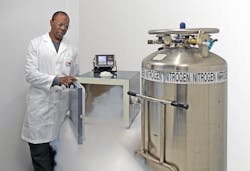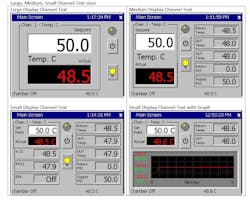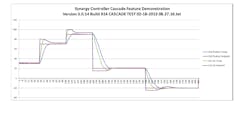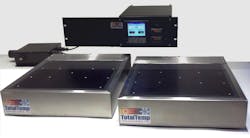Download this article in .PDF format.
Thermal testing systems have come a long way to meet the requirements of current modern automobile manufacturing. Within the life of some people around today, we have progressed from full automobile electrical schematics that fit on one page, and engine electrical components housed in wooden boxes, to sophisticated computer systems that would have made the heads of people spin in the day of Henry Ford or Karl Benz.
The overall cost/benefit of consumer vehicles has slowly been tipping toward the electric vehicle. Given the great recent advances in battery cost and weight per kWh and optimized battery management systems, electric cars have become even more practical. Additionally, charging infrastructure deployment and the cultural appeal of lowered emissions and energy independence, all push us toward more and better battery vehicles.
Addressing Test Systems
Well-implemented thermal test systems offer automation features which can help coordinate test timing, charge/discharge scenarios with the temperature control while monitoring multiple points of the battery or control systems. Further distinctions of a well-implemented thermal test system would be as follows:
● A capable system that has good convection or a good conductive heat transfer path to get sufficient heat in and out of the parts with efficiency. For example, a chamber with poor airflow would appear to be "at temperature” when parts in the chamber, especially the internal temperatures of massive parts are likely nowhere near the indicated and required air temperature.
● A system should have enough feedback from sensors in and on the load to be able to minimize test time and have real knowledge of when parts are at needed temperatures without blindly waiting for temperature settling. Modern temperature control algorithms have progressed quite a bit offering big improvements in speed and setpoint verification without a lot of specialty hardware and time spent tuning control parameters.
● Good coordination between the driving temperature and other tests which need to be done at specific temperatures is important to avoid unnecessary waiting for a setpoint or performing tests at the wrong temperature. Just having a test that is going to be repeated many times take more time than really required to accomplish can and should be avoided.
● Any temperature overshoot must be properly controlled so that it does not damage parts. While some overshoot is really a good thing and gradients are needed to make the temperature of an item change, too much of a good thing can always cause damage.
● More fully thought out systems are always a good thing down to the point of when refrigeration systems are used in a building, they are designed so that the heat they dump into the room and ultimately building HVAC systems is considered.
● Everyone wants reliable systems that don’t fail, randomly slow down testing, cost more money or impact production testing plans.
● Easy to use features and functionality is important for providing real ongoing savings in thermal test without taking hours and hours to implement.
● Proper automatic monitoring of parameters that could go wrong and cause test data to be invalid is important too. Prior thought about choices of saving a long test that may fail, the ability to resume / restart from the beginning if required or to have proper corrective action taken in real time before test parameters go out of range.
Heat Transfer
Conductive heat transfer is almost always faster and more efficient than heat transfer by convection. However, convection requires direct contact with the device under test. In most cases in the real world, there is some heat transfer happening from convection and some by conduction. In many cases the combination of controlled conductive heat transfer with convection can provide optimal thermal testing speed and better simulation of field conditions. Conductive heat transfer as with thermal platforms also facilitates a spark-free environment with easy provision for battery venting as needed along with the improved heat transfer.
For example, the majority of TotalTemp products use Liquid Nitrogen as a coolant. L-N2 quickly provides cooling at nearly any rate or load capacity needed to accomplish testing as specified, or otherwise as quickly as required. Liquid Nitrogen is very cost effective in heat removal per BTU plus a couple of hidden factors. The simplicity of liquid nitrogen cooling systems with just one moving part is hard to beat for initial cost savings and long term reliability.
Addressing the issue of thermal control, the company’s Synergy Nano temperature controller simplifies and automates many testing functions, using a bus interface with remote functionality, GPIB, RS232, RS485, and web server control. The controller also supports Telnet and FTP protocols, with sample code and drivers for LabVIEW, C++ and Python available. Intelligent multiple point temperature control (Cascade control) is also very useful and can be easily implemented to increase the effectiveness in getting parts to temperature faster.
This function allows the user to specify a controlled maximum amount of temperature overshoot, while monitoring key device locations to allow faster approach to the desired temperature without overstressing batteries. Multi point logging capabilities provide useful test data and easily save the big costs of independent temperature logging gear. Additional data storage is automatically correlated with the setpoint temperatures or other data. Detailed options of which and how much data to be logged are provided. Logging configurations are easily managed for logging durations and buffer management to prevent lost or overwritten data.
Additionally, the Synergy supports alarm inputs and outputs for sensors such as open door, gas detection and out of range conditions to name a few. Further capabilities include automated transfer of test data to a server location to keep results safe (cloud features) and organized without technician intervention. Test results can even be automatically emailed as a PDF or plotted on a network printer. Alarm conditions can be programmed to halt with requirement of user intervention or to just resume if error conditions subside.
Audible, visual, email or text message alerts can be easily configured to report end of test or error conditions that require operator attention. Other customization features for battery testing include regulated gas purge systems with multiple flowmeters, as previously mentioned CO and H2 detection, hold down clamping and special exhaust or muffler provisions.
Looking Forward
Automobile reliability, safety and costs are holy grails that much has been said about. Improved battery testing helps designers and manufacturers achieve these goals, in the face of the great complexity that the modern electric automobile has grown to. Many new materials still are being tried to find optimum systems, addressing the growing array of standards. Battery testing involves high temperatures, low temperatures, thermal shock conditions, or cases where a battery may possibly vent or rupture.
Thermal platforms and custom temperature chambers provide the environmental parameters needed to properly develop and more easily manufacture or test battery systems. Accurate thermal simulations of stresses can be readily performed such as thermal shock or uneven heating/cooling as might be experienced with active or massive loads. Ordinary and extreme operating conditions as seen in Minneapolis in the winter, or Death Valley in the summer, must be verified and can be readily combined with other known stresses such as short circuit, excessive loads or user errors.



